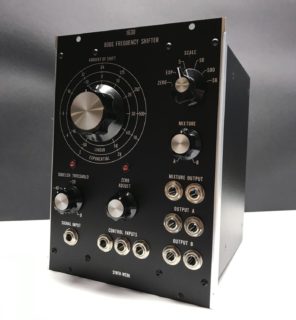 Munich-based Synth-Werk has introduced the SW 1630 Bode Frequency Shifter, a third-party clone of the rare Moog 1630 module.
Munich-based Synth-Werk has introduced the SW 1630 Bode Frequency Shifter, a third-party clone of the rare Moog 1630 module.
A frequency shifter is an audio signal modifier which shifts the entire frequency spectrum of the applied signal by a given amount. It delivers completely different effects than speeding up/slowing down audio or digital pitch-shifting, because frequency shifting changes the ratios between the frequency components of the audio. This can create effects ranging from subtle chorusing to complex, clangorous tones.
The Model SW 1630 Bode Frequency Shifter allows the amount of shift to be controlled over a span of -5000 Hz to +5000 Hz, utilizing voltage and/or manual control.
Synth-Werk makes a line of full-size Moog module clones, using the original designs and hand-assembly. The modules are built by hand-stuffing and hand-soldering components to circuit boards, using traditional wiring methods. The faceplates are etched, as the original Moog modules.
Their modules follow the Moog format (5U industry standard), but use modern Synthesizers.com connections, so they can be easily integrated with “Dotcom-compatible’ systems. The modules can also be modified to work with Moog power supplies.
Pricing and Availability
The SW 1630 Bode Frequency Shifter is available for 1.950,00 Euro. A rack-mount version, the SW 735 Bode Frequency Shifter, is available for 2.250,00 Euro.

The Bode Frequency Shifter is “THE” frequency shifter. What it does is completely unique.
It’s very difficult to recreate well, though. The only modules that get close to the original are straight clones, which tend to be expensive, and the Encore Electronics version, which is sort of the ‘DCO version’ of the Bode design.
I’ve got the Encore Electronics version and it is fantastic, but people that have used the Bode say that they can hear the difference with certain settings.
Behringer announced it for about 200 usd.
The original Bode Frequency shifter and the SYNTH-WERK one consist of 4 boards packed with unique and hard to find components. All of them need to be selected and matched, otherwise you do not get the result it should be. Even most of the old Moog 1630 FS have a dead spot in the +-5Hz range because of not selected and aged components. The calibration work on the 1630 is very intensive and you have to adjust many, many trimmers in the right way and in the right flow. It took us about 3 years of research work to get it finally done. How would Behringer be able to get this done for 200 USD? This is not serious and it is a shame for every serious engineering work!
Gerhard, people doesn’t care if it sounds like the original, they only judge according to the price. I’ve seen so many videos of the Behringer Moog modular clones and to me it sounds nothing like the real deal, but people are happy to have it for a fraction of the price. I can’t afford a Moog modular but also won’t settle for a bad sounding clone.
Hi Gerhard, let just be honest here. If you own most of the supply-chain, then you can also make a cost-effective production.
Let’s be honest here – we all know that there are differences between making a cheap copy and making a full-size, part-for-part, reproduction of a classic design.
The differences don’t matter to a lot of people, but they do if you want the real thing vs an approximation.
The Behringer Moog module knockoffs look like small versions of the originals, but they have very different circuits, build and sound. The Behringer Fixed Filter Bank for example, is an inexpensive copy of the Synthesizers.com version of the original Moog design. So it sounds and works very different than the original.
I think it’s cool that the market has options at the low and high ends now, and wouldn’t be surprised if some percentage of the people that get started with knockoff modules end up moving on to Moog reissues or one of the full-size clone systems.
Pretty sure that comment was just a joke about the current state of the synth market. Don’t get too hung up on it.
Excellent! The legend lives on.
It certainly is a huge task to create one (look at the Haible version).
I’ve thought about a dedicated VST host for running the Fullbucket plug-in one even as a solution!
https://patchstorage.com/delay-like-oskar-sala/
Cool
Check this:
https://www.fullbucket.de/music/freqshifter.html
A big congratulations to Gerhard and the team for tackling this very complex and important piece of electronic music history. A frequency shifter was absolutely essential to the sound design and performances of the late Oskar Sala on his Mixtur-Trautonium, and for those hoping to preserve and continue the legacy of this beautiful instrument, this product represents a critically important ingredient.